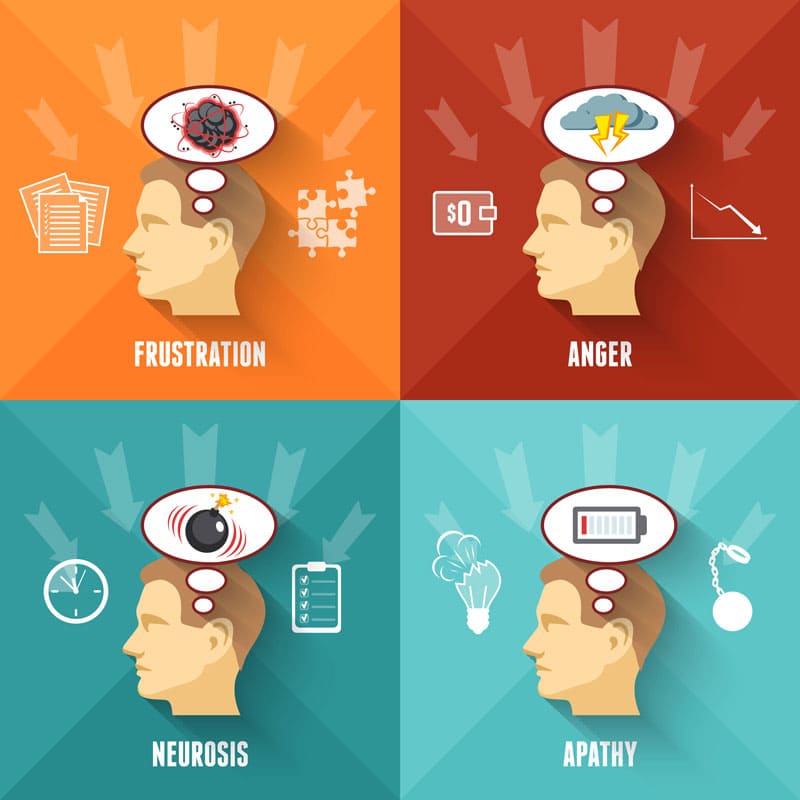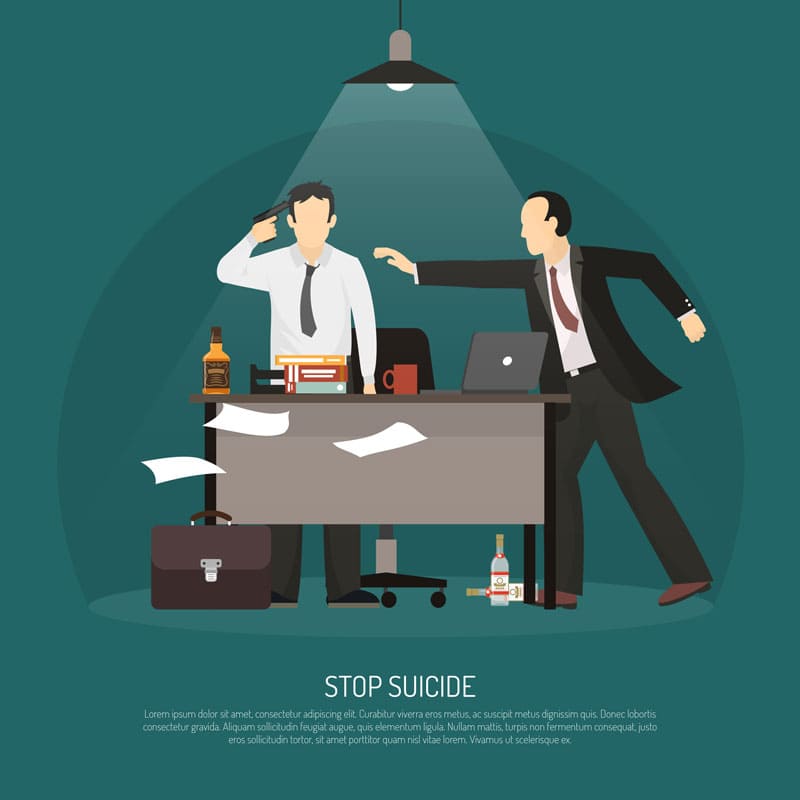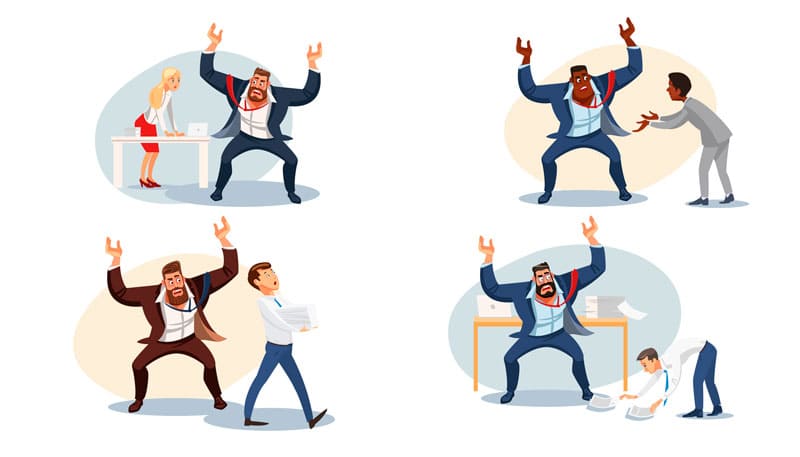---
Lawyer burnout often leads to illness
Much has been written in recent years about 'burnout' and mental illness among lawyers.
Despite this, an increasing number of lawyers are reporting high levels of stress, anxiety and depression, much of which is work related.
Law is a complicated area which is in constant change, therefore, lawyers are pressured to adjust to those changes and being able to face them.
This paper outlines the concept of 'burnout',
- from its origin in the 1970s through to the World Health Organization's three-part working definition in 2019;
- looks at the vital relevance of the concept for legal practitioners;
- highlights outcomes from a number of studies conducted in various jurisdictions worldwide into lawyers' mental health;
- identifies common issues and pressures which may provide clues as to why burnout is currently so prevalent in the legal profession;
- considers social and psychological factors at play in the legal world which may predispose to mental illness;
- reviews selected initiatives which attempt to enhance wellbeing and good mental health in the profession.
Lawyers will find simple practical ways to help them to assess whether they may be at risk of burnout and, more importantly, what steps they can take to address the risk and to stay healthy.
At an organizational level, principles to support wellbeing in the workplace are outlined to help law firm managers and others in a supervisory role.
Take home
Enhancing wellbeing in the legal profession cannot be a matter of compulsion, but rather one of cultural change
Full article
Lawyer Burnout: what is it and what can we do about it?
Introduction
From its humble beginnings as a metaphor for occupational exhaustion amongst people working with long-term drug addictions in the early 1970s, 'burnout' has become a universal concept. Definitions vary but it has now become an everyday part of popular and academic psychology and most languages have their own word for the concept (Schaufeli et al., 2009). This article, whilst acknowledging the significance of the vast amount of research into the concept, will emphasise the practical usefulness of the concept and ways of addressing burnout amongst lawyers, law firms and legal institutions. It is illustrated by anonymised vignettes informed by the author's experience in law and psychotherapy. All case studies are disguised, adapted or composites, to protect confidentiality.
'Burnout' - what is it?
The concept of burnout was first brought to public awareness in 1974 by a psychologist working in New York, Herbert Freudenberger, who borrowed the term from the illicit drug scene where it was colloquially used to refer to the devastating effects of chronic drug abuse. Freudenberger also used the term to describe a gradual loss of motivation and commitment amongst volunteers in the free clinic in which he worked (Schaufeli et al., 2009).
Over time he noticed that changes in attitude, mood, motivation and personality were becoming obvious amongst workers in the clinic (Maslach and Leiter, 2008). In line with the significant pressures placed upon them, he noticed that volunteers experienced a number of common and interrelated factors, including a compulsion to prove themselves, neglecting their personal needs, revising their personal values and denying emerging problems. Many became socially withdrawn and showed obvious detrimental behavioural changes, became more cynical in their attitude towards the addicts they were working with and prone to depressive illness. Freudenberger summarised these common developing factors with the term 'burnout' (Freudenberger, 1974).
Around the same time Christina Maslach, an academic in California, came across the term 'burnout' which human services workers were using for the same or similar states of exhaustion. She noted that the workers often felt emotionally exhausted, that they developed negative perceptions and feelings about their clients or patients, and that they experienced crises in professional competence as a result of the emotional turmoil that they were experiencing. Maslach developed a method for assessing burnout as a multidimensional construct that went beyond simple exhaustion. She described it as "a syndrome of emotional exhaustion, depersonalisation, and reduced personal accomplishment that can occur amongst individuals who work with people in some capacity" (Schaufeli et al., 2009). Her assessment tool, the Maslach Burnout Inventory (MBI) is now the most widely accepted measure of the concept of burnout (Maslach and Leiter, 2008).
During the 1980s 'burnout' was accepted into colloquial usage. In the 1994 edition of the World Health Organisation's (WHO) International Classification of Diseases (ICD-10 Z73.0) 'burn-out' was introduced and described as "a state of vital exhaustion". Research burgeoned and by 2008 no fewer than 6,000 academic papers had been written on the concept (Schaufeli et al., 2009). In 2009 'burnout' was described in The Lancet as "an experience of physical, emotional, and mental exhaustion, caused by long-term involvement in situations that are emotionally demanding"(Mateen and Dorji, 2009).
In May 2019 burnout was included in the 11th revision of the ICD as an occupational phenomenon (World Health Organisation, 2019). Specifically, it is not classified as a medical condition. The ICD-11 states that, "burn-out is a syndrome conceptualised as resulting from chronic workplace stress that has not been successfully managed. It is characterised by three dimensions:
- feelings of energy depletion or exhaustion;
- increased mental distance from one's job, or feelings of negativism or cynicism related to one's job; and
- reduced professional efficacy."
The WHO is now embarking on developing evidence-based guidelines on mental wellbeing in the workplace. The new WHO definition mirrors Maslach's conceptualisation of the construct in the 1970s.
After 45 years of investigation into the concept of burnout the WHO acknowledges that much work is yet to be done and that the concept has hitherto been ill defined. The precise definition of the term is clearly essential for any definitive exploration of the concept; however, for practical purposes the writer's view is that the continued colloquial use of burnout is helpful on a practical level in reducing the stigma surrounding mental illness in the workplace. It seems easier and more acceptable in many cultures for a staff member or leader to describe themselves as 'burnt out' rather than as suffering from anxiety or depression.
A similarly useful euphemism for mental illness is the word 'stress'. In many English speaking cultures this can be a helpful (and less stigmatising) catch-all word for anxiety, depression or other mental illness triggered by excessive workplace or other pressures. In its 2018 report the UK Health and Safety Executive (HSE) describes workers' experience of work-related stress, depression or anxiety as a "harmful reaction people have to undue pressures and demands placed upon them at work" (Health and Safety Executive, 2018). In passing, it is interesting to note that UK workers attributed 44% of their stress, depression or anxiety to workload, 14% to lack of support, 13% to violence, threats or bullying, 8% to changes at work and 21% to other causes.
Burnout in the legal profession - where are we at?
Now let me give you some statistics. The point of these statistics is to make a point. We will start with the most recent and then work backwards over the last few years. This information is merely the thin coating on the top of the iceberg. A massive amount of literature has accumulated on lawyer wellbeing and mental health, particularly in the last decade. These figures simply provide a flavour of what is happening in a number of in jurisdictions worldwide. However, as the practice of law crosses all cultural boundaries, the principles behind the stats will be relevant to most.
The International Bar Association (IBA) Global Employment Institute report in 2019 observed that many countries had noted that absenteeism due to stress and mental health problems continued to be problematic. However, a lack of formal studies had hindered identifying specific trends in the area. To addresses these challenges, several countries (including Canada, Colombia, Denmark, Finland, Taiwan and the UK) had proposed new legislation or other initiatives. In Portugal, for example, calls have been made for the national government to adopt legislation to give employees suffering burnout syndrome the same protection provided by laws that compensate workers for occupational accidents. Others, such as Argentina, France, Italy and Kenya had chosen to let employers handle issues related to employee stress and absenteeism (IBA Global Employment Institute, 2019).
In England and Wales the Law Society's Junior Lawyers Division's resilience and wellbeing survey report in 2019 noted that 93% of respondents reported feeling stressed in their role the month before completing the survey, with almost a quarter of those individuals feeling severely or extremely stressed. The survey showed that the key stress factors for junior lawyers are high workload, client demands and expectations, lack of support and ineffective management. Over 77% of respondents said that their firm could do more to support stress at work (The Law Society, 2019).
Marta was a trainee lawyer. Her supervisor was aware that her father had died in a road accident two years previously. Ignoring any potential repetition of her traumatic bereavement, her supervisor required her to attend the site of a fatal industrial accident on the day when an employee had been crushed by a lorry so that she could prepare a report and advise the directors of the client company on how to manage traumatised staff and defend any potential lawsuit. The expectation was that she would have all the skills of a lawyer qualified for several years. She told me that within two weeks of the assignment she had a nervous breakdown.
No level of seniority in the legal profession is immune to mental illness. It affects office juniors as well as the judiciary. UK District Judge Helen Conway wrote in 2019, "stress-related depression and anxiety recently forced me to take 11 months out from my job as district judge … I felt utterly exhausted, depleted and useless" (Conway, 2019). It affects academics and students as well as those in legal practice. An array of studies and data sets highlight a significant and worsening problem of poor wellbeing and mental health amongst academic staff (Collier, 2019a). A 2009 study in Australia reviewed attitudes towards depression in Australian law students and lawyers. It revealed high levels of psychological distress and the risk of depression amongst the cohort who participated when compared with Australian community norms and other tertiary student groups. (Kelk et al., 2009)
No level of seniority in the legal profession is immune to mental illness
A survey conducted by the Iberian Lawyer magazine (2018) found that an overwhelming majority of lawyers working in Spain and Portugal believed that their profession was not doing enough to tackle mental illness among lawyers. A number of the participants knew colleagues who had taken their lives through depression. The vast majority of respondents to the survey said they believed a large workload was the most common cause of the mental health problems they or their colleagues had suffered. 80% of respondents said that either they or a colleague had suffered from mental health problems at some point during their career as a lawyer.
The UK and Ireland lawyer support charity LawCare's recent report noted that it had received the highest ever number of calls from lawyers in 2018, with calls about bullying and harassment nearly doubling. The most common reasons for calling the helpline were stress (26%), followed by depression (19%) and anxiety (11%). The charity's CEO Elizabeth Rimmer noted an increasing concern about the long hours and heavy workload culture in the law which significantly affected wellbeing (LawCare, 2019a).
The UK HSE report of 2018 noted that the 'Professional' occupations category had a statistically significantly higher rate of work-related stress, depression or anxiety than the rate for other occupations (Health and Safety Executive, 2018).
In April 2015 the Bar Council for England and Wales published a comprehensive report 'Wellbeing at the Bar' (The Bar Council, 2015). The Council was keen to better understand levels of wellbeing across the Bar and to identify what interventions and resources might be put in place to support practising barristers' general wellbeing. Of those surveyed (about one sixth of the profession), around one in eight barristers felt emotionally exhausted and over a half did not sleep properly. Around two thirds indicated that they thought their present levels of stress had a negative impact on their work performance. Many respondents indicated that most or all of the time they found it difficult to control or stop worrying (33%), tended to dwell on their mistakes (35%), tended to feel nervous, anxious or on edge (24%), tended to be very critical of themselves (59%) and experienced unpleasant physical symptoms when they felt stressed, for example headache, fatigue, palpitations, upset stomach, and aching muscles (28%).
A study of occupational stress and burnout amongst lawyers in a district near Miraj in India found that female lawyers were experiencing significantly greater stress and burnouts compared to males; that job satisfaction was significantly and negatively correlated with stress; and that "the need of the hour is to make an effort in coping with stress amongst lawyers" (Patel et al., 2012).
A study of Taiwan lawyers found a high prevalence of self-perceived work stress. Litigious lawyers there had higher work-related burnout and higher client-related burnout than non-litigious lawyers. Personal burnout and work-related burnout were associated with high psychological demands, effort, and effort-reward ratio (Tsai et al., 2009).
How did we get here?
Bearing in mind the HSE statistics on the causes of stress-related illness in the workplace (Health and Safety Executive, 2018) and in line with what appear to be similar pressures in service industries worldwide, it seems reasonable to assume that the nature of burnout in the legal profession generally follows a similar trajectory. Lawyer burnout is likely to be caused or contributed to by one or a combination of the generic causes of mental illness in the workplace, namely workload (particularly working to tight deadlines, taking on excessive work or responsibility or experiencing excessive pressure), lack of managerial support, violence, threats or bullying, organizational changes at work, role inconsistency (lack of clarity about the job description or requirements) and 'other causes'. We will look in particular at other causes which are especially relevant to lawyers.
In passing, it is noteworthy that compared with the rate across all workplace sizes small workplaces (fewer than 50 employees) had a statistically significantly lower rate of workrelated stress, depression or anxiety while larger workplaces (250 + employees) had statistically significantly higher rates. Medium sized organizations (50 - 249 employees) were not significantly different from the rates across all workplaces (Health and Safety Executive, 2018).
Research has been undertaken as to whether certain personality types may be predisposed to work-related burnout. The findings are so far inconclusive but it may be that those of a more conscientious and/or neurotic nature may be more vulnerable (Maslach and Leiter, 2008).
Certain traits are vital if a lawyer is to work competently. A draughtsman must be conscientious, perfectionist, thorough and attend to fine detail. A partner in a law firm has to be resilient, independent and self-reliant. An associate who is driven and has high expectations of their own performance is more likely to achieve than one who is not. An advocate who is persuasive, sceptical, good in debate and who has strong personal charisma is likely to be more effective than others. An attorney who is good on paper will benefit from being analytical, intellectual, cautious and be able to see both sides of an argument. This, however, is just one side of the coin. On the other, where these characteristics become closely woven into a lawyer's sense of identity, personal satisfaction, self-esteem, and relationships they can become self-destructive (Lyon, 2015: 19). "Thinking 'like a lawyer' is fundamentally negative; it is critical, pessimistic, and depersonalising. It is a damaging paradigm in law schools because it is usually conveyed, and understood, as a new and superior way of thinking, rather than an important but strictly limited legal tool" (Kreiger, 2002). And some have simply worked themselves into areas of legal practice for which they are temperamentally unsuited.
After six months off work and a career change, John (an advocate in his 40s) told me, "That night after court was crash and burn. In the morning as I was walking to court every step I took was harder. My legs felt like lead. I knew that I had prepared well but there was something about standing in court that was overwhelming. I realised after the hearing that I was just not cut out for advocacy".
Sadly, bullying and sexual harassment continue to be common in legal workplaces. A recent IBA survey of the legal profession from 135 countries revealed that one in two female respondents and one in three male respondents had experienced bullying. Sexual harassment was also found to be common with one in three female respondents and one in 14 male respondents having been sexually harassed in a work context (International Bar Association, 2019).
For some the pressures caused by workplace stress are cumulative; for others they are sudden and immediately overwhelming.
"I was getting on fine at work. I had made partner by my mid-30s. Home was good, family was great, the money was good. Work was hard and the hours were long but it felt rewarding. I was coping - just. Then suddenly it was like I was handed a lump of kryptonite. My Superman image crumbled. My energy drained. Everything was exhausting. That was just after my wife got her diagnosis of stage three lung cancer." (Andrew. Corporate lawyer.)
Some work types are inherently demanding, especially those involving clients or witnesses who have experienced trauma.
Jennifer was an able advocate with a growing reputation and caseload in prosecuting child abuse cases. After about seven years her reputation was such that her workload was almost exclusively related to child sexual abuse. In addition to the long working hours, the distressing and traumatic nature of her caseload began to take its toll. She had nightmares, poor sleep, was continually exhausted and felt that she was beginning to treat the victims as robots. Her attitude to the work became more cynical. She had begun to see the warning signs and wondered if she should give up this work type.
Some lawyer psychodynamics
Human experience is multifactorial. We have bodies and minds. We share aspects that are seen and unseen, conscious and unconscious. Events occur around us and inside our minds. There is an interaction between memory, present experience and future expectation. Our interpretation of overlapping subjective and objective meanings of events, relationships and situations will vary from time to time. There is an interaction between our bodies, minds and society around us and an interplay between bodily sensations, thoughts, feelings and environment. We are rather complex beings.
There is an interaction between our bodies, minds and society around us and an interplay between bodily sensations, thoughts, feelings and environment. We are rather complex beings
On a simple level, the way that we think, feel and socialize could be compared to the cause and effect of balls shooting around a pool table. In reality it is more like the hugely complex interactions within the human brain. With this in mind, and with a view to making things manageable, we will limit ourselves to the frames of reference for burnout outlined by Freudenberger and Maslach introduced above.
Recognising that a worker's internal experience of strain is assumed to play a mediating role between the impact of external job demands (stressors) and work-related outcomes (such as absenteeism or illness), Maslach and Leiter (2008) proposed a 'Burnout - Engagement' model. Drawing on research into burnout over three decades they conceptualized people's psychological relationships to their jobs as a continuum between the negative experience of burnout and the positive experience of engagement. In this context of 'engagement' is defined as "an energetic state of involvement with personally fulfilling activities that enhance one's sense of professional efficacy". They described three interrelated dimensions of the continuum operating within six key domains of the workplace environment (workload, control, reward, community, fairness and values):
- exhaustion-energy,
- cynicism-involvement, and
- inefficacy-efficacy.
'Looking back, it was my year from hell'. Peter (a senior partner in a large law firm) was reflecting on a period of about nine months when everything seemed to go wrong. He had unexpectedly lost a key member of his department. He was unable to recruit a replacement and his workload virtually doubled for several months. His wife had been unwell and his father had died around the same time. He was able to hold things together for a while, but his sense of connection with his colleagues and clients seemed to evaporate and the increase in work and additional responsibility gradually overloaded him. He was ashamed that he occasionally had thoughts about ending it all. He consulted his doctor who diagnosed clinical depression, prescribed medication and referred him for therapy.
Burnout commonly overlaps with clinical depression. The lawyer feels exhausted, hopeless, indifferent, and may feel that life has no meaning
In Maslach and Leiter's model Peter's energy was drained, he detached from people and his work output suffered. His experience also overlaps closely with Freudenberger and North's 12 phases of burnout (Kraft, 2006). The stages can be regarded as factors in a constellation of experience. They are not necessarily sequential, but for many forms a recognizable pattern:
1. A compulsion to prove oneself.
Most lawyers start their careers with ambition. This can turn into determination and compulsion when pressures increase. Pressure to hit billing targets and hours worked often start on day one. And then one needs to keep up with peers and not to be out-performed.
2. Working harder.
They then need to maintain targets and put in long hours. This can lead to an obsession with autonomy and independence. Some will develop a notion of their own irreplaceability. Sometimes this can lead to trying to fit into an organization that they realize does not suit them.
3. Neglecting one's needs.
With most of their energy devoted to work, sometimes little time is left for relaxation and recreation. Relationships begin to suffer, and sleep is lost. Initially this can seem like a necessary and altruistic commitment to one's career or organization. It can be exciting to feel like a martyr.
4. Displacement of conflicts.
A vague sense of unease develops, a sense that something is not quite right. But at this point it feels easier to try to cope with the pressures rather than to think about the underlying anxieties. Often around this time physical symptoms can begin to present themselves.
5. Revision of values.
Isolation, avoidance of conflict and the lawyer's denial of basic physical needs can change their perceptions. Personal values are revised and one's standard of evaluating self-worth is transferred to work status and achievement. This can lead to emotional blunting.
6. Denial of emerging problems.
Others now begin to notice, but tolerate, behavior al changes such as negativity, irritability, and self-preoccupation. The lawyer may become less sociable, or aggressive or sarcastic. They begin to acknowledge the pressures but attribute them to work demands, rather than to the way that they have adapted to cope with the cultural expectations of the workplace.
7. Withdrawal.
Some become withdrawn and socially isolated. Social contact is reduced to a minimum. They can feel increasingly without hope or direction. It is easy at this point to turn to alcohol, drugs or other potential addictions.
8. Obvious behavior al changes.
Gradually colleagues, clients and family are unable to overlook the behavior al changes. Fellow lawyers may talk behind backs about colleagues and clients may make a formal complaints. Conflict in the workplace and at home can become the norm.
9. Depersonalization.
Lawyers no longer see themselves or others as valuable and no longer perceive their own needs. All that matters is what is happening at the moment; past and future are forgotten. Living can turn into a series of mechanical functions.
10. Inner emptiness.
People experience a sense of inner emptiness and may use food, drugs, alcohol, sex or gambling to fill the void. Leisure time can feel like dead time.
11. Depression.
Burnout commonly overlaps with clinical depression. The lawyer feels exhausted, hopeless, indifferent, and may feel that life has no meaning.
12. Burnout syndrome.
At this point suicidal ideation is common. Sometimes it is acted out. Immediate medical attention is required following mental and physical collapse.
Where to now?
"Not more regulation … please!" was the exasperated (and censored) response of one of the delegates after I had given the presentation at a law conference several years ago. I was outlining aspects of wellbeing and mental health in the legal profession and suggested that the Solicitors Regulation Authority for England and Wales might be persuaded to incorporate a requirement for law firms to consider employee wellbeing as part of their forthcoming Competence Statement for solicitors. This suggestion was received by at least one lawyer with horror.
On reflection, I now agree with the delegate's sentiment. Enhancing wellbeing in the legal profession cannot be a matter of compulsion, but rather one of cultural change. And if the increasing number of studies into lawyer wellbeing is any measure, it seems the culture is changing. Slowly.
All organizations have a culture of their own. The rituals and values of the organization are determined by its leaders, its history and the role characteristics attributed to and performed by those working in the organization. When exploring the concept of burnout we need to assess the impact on an individual of these organizational values (Maslach and Leiter, 2008). As we saw in the HSE report, (Health and Safety Executive, 2018) it seems larger organizations are generally prone to higher rates of stress related illness and, without determined proactive initiative, will be inherently less adaptable and responsive to employee strain through sheer size of the workplace.
So, what can individuals and organizations do to improve resilience and reduce the risks of burnout?
Individuals
The Five Ways to Wellbeing are a set of evidence-based actions which promote wellbeing. The activities are simple things individuals can do in their everyday lives. They were developed by the New Economics Foundation from evidence gathered in the UK government's Foresight Project on Mental Capital and Wellbeing (New Economics Foundation, 2011) and are simple, adaptable, universal and holistic. The project drew on research into mental capital and mental wellbeing throughout life. The Five Ways are a summary of the project's findings. They have been used by health organizations, schools and community projects across the UK and globally to help people take action to improve their wellbeing. They are:
- Connect. Evidence indicates that feeling close to, and valued by other people is a fundamental human need and one that contributes to functioning well in the world.
- Be active. Regular physical activity is linked with lower rates of depression and anxiety.
- Take notice. Studies have shown that being aware of what is taking place in the present moment directly enhances wellbeing.
- Learn. Continued learning through life enhances self-esteem and encourages social interaction and a more active life.
- Give. Participation in social and community life has been shown to enhance wellbeing.
In addition to providing a telephone helpline for lawyers in the UK and Ireland, legal charity LawCare has many resources for thinking about wellbeing both from an individual and organizational perspective (lawcare.org.uk). Many other law associations providing lawyer support, particularly in the USA and Australia, provide useful guidance. A simple internet search in a lawyer's own jurisdiction will reveal what is available. However, in countries where such support is unavailable, the LawCare site will be a helpful first point of reference.
Organisations
LawCare has also published information for creating mentally healthy legal workplaces (LawCare, 2019b). This includes guidance on fostering a culture of wellbeing, reducing stigma, identifying mental health champions, enhancing work / life balance, including mental health training as part of ongoing learning, mentoring, peer support and supervision. Working through and applying these steps will go a long way to reducing the likelihood of staff burnout. As we noted, burnout is an outcome of badly managed chronic workplace stress (World Health Organization, 2019).
Burnout is an outcome of badly managed chronic workplace stress
The introduction of mental health first aid (MHFA) training in organizations is enabling staff to recognize signs of strain in co-workers and to take steps to address them at an informal level. MHFA helps to educate and to de-stigmatize the experience of mental illness in the culture of an organization (MHFA, 2019).
A recent comprehensive report published by the City of London Corporation (2014) into promoting best practice in employee health and wellbeing in the City contains useful generic guidelines for best practice. The authors note that mental wellbeing is the area of workplace health which most companies wanted to develop. With the exception of some examples, mental health is generally not integrated and managed within the workplace by City organizations, with provision being very much at an individual level. Management training for recognizing and managing mental health issues is becoming increasingly common. Steps for best practice include health promotion and wellness program, mental health program and the need for organizational approaches involving holistic embedded approaches to workplace health improvement. It is noted that health and wellbeing are inextricably linked to the bottom line of business. This ties in exactly with the observations above concerning energy, involvement and efficacy leading to staff engagement (Maslach and Leiter, 2008).
On an international level, the IBA's 10 recommendations for addressing bullying and sexual harassment in the legal profession apply equally to the avoidance of burnout, namely raising awareness, revising and implementing policies and standards, introducing regular customised training, increasing dialogue and best practice sharing, taking ownership of the problem, gathering data and improving transparency, exploring flexible reporting models, engaging with younger members of the profession, appreciating the wider context, and maintaining momentum (International Bar Association, 2019).
Richard Collier, law professor at Newcastle University in the UK, has observed these pressures firsthand amongst academics and students. He, amongst others, has highlighted the need for focus on the place of emotion in a traditional university law degree, what it means to learn to 'think like a lawyer' and how wellbeing might be better embedded with legal education and training, and when transitioning from an educational setting to a career as a young lawyer (Collier, 2019b). His and other voices echo Freudenberger's plea three decades ago to "consider what values our training institutions and universities impart that do not prepare us for what we will find once we enter our professions and work in our chosen fields" (Freudenberger, 1989). Interestingly, as a result of the initiative of the newly formed Mental Health Institute of Legal Professions in Spain, in early 2019 the Catalan Bar Association introduced a regulation emphasising the need for members' training in 'emotional intelligence, empathy and active listening skills' to enhance their professional competence and wellbeing (ISMA, 2019). From small acorns …
Conclusion
In her 2008 report on mental illness and substance abuse among lawyers and law students in the USA Laura Rothstein, professor of law at the University of Kansas, wrote, "Although there is a great deal of research and information on these issues, it is difficult to synthesise and assess what is working" (emphasis mine) (Rothstein, 2008).
Well, as we have seen, much has been done over the last decade to analyses what works and what does not. An increasing number of larger law firms worldwide have been making lawyer wellbeing an essential and integral part of their business. For the most part there seems to be a growing recognition that if the welfare of its people is prioritized, a firm's productivity and profit will look healthier too.
Healthy systems of justice worldwide depend on mentally healthy lawyers
However, this is not merely about growing healthy organizations. Law holds together the framework of society, from families to nations. Lawyers are the voice of the voiceless. If we are not able to play our part in maintaining the rule of law and defending human rights, who will? Lawyers on their way to burnout undermine the framework. The voiceless are silenced. Healthy systems of justice worldwide depend on mentally healthy lawyers.
- The Bar Council (2015), 'Wellbeing at the Bar' available at
- City of London Corporation (2014), 'Best Practice in Promoting Employee Health and Wellbeing in the City of London' available at
- Collier, R. (2019a), 'The Wellbeing of Legal Academics – A Missing Piece of the Legal Profession's 'Wellness' Turn?' available at
- Collier, R. (2019b), 'How do we tackle the legal profession's mental health problem?' available at
- Conway, H. L. (2019), 'Bringing mental illness into the open' available at
- Freudenberger, H.J. (1974), 'Staff burnout', Journal of Social Issues, 30, pp.159-165
- Freudenberger, H. J. (1989), 'Burnout: Past, Present, and Future Concerns'. In Wessells Jr., D. T., Kutscher, A., Seeland, I.B., et al. (eds.), 'Professional Burnout in Medicine and the Helping Professions', Routledge, New York.
- Health and Safety Executive (2018), 'Work related stress depression or anxiety statistics in Great Britain, 2018', available at
- Homer, (1946), 'The Odyssey (translated by E. V. Rieu)', Penguin Books, London.
- IBA Global Employment Institute (2019), 'The Seventh IBA GEI Annual Global Report – National regulatory trends in Human Resources law' available at
- Iberian Lawyer (2018), 'The secret terror' available at
- International Bar Association (2019), 'Us too? Bullying and Sexual Harassment in the Legal Profession' available at
- ISMA (2019), 'Day of celebration for Catalan lawyers' available at
- Kelk, N. J., Luscombe, G. M., Medlow, S. & Hickie, I. B. (2009), 'Courting the Blues: Attitudes towards depression in Australian law students and lawyers', BMRI Monograph 2009-1, Brain & Mind Research Institute, Sydney.
- Kraft, U. (2006), 'Burned Out', Scientific American Mind, 17, pp.29-33.
- Krieger, L. S. (2002), 'Institutional Denial About the Dark Side of Law School, and Fresh Empirical Guidance for Constructively Breaking the Silence', Journal of Legal Education, 52, pp.112-129.
- LawCare (2019a), 'Calls to lawyer helpline about bullying and harassment increase' available at
- LawCare (2019b), 'Creating Mentally Healthy Legal Workplaces' available at
- The Law Society (2019), 'Junior Lawyers Division Resilience and wellbeing survey report 2019' available at
- Lyon, A. W. (2015), 'A Lawyer's Guide to Wellbeing and Managing Stress', ARK Group, London.
- Maslach, C. and Leiter, M. P. (2008), 'Early Predictors of Job Burnout and Engagement', Journal of Applied Psychology, 93, pp.498-512.
- Mateen, F. J., and Dorji, C. (2009), 'Health-care worker burnout and the mental health imperative', The Lancet, 374, pp.595-7.
- MHFA (2019), Mental Health First Aid International Guidelines available at
- New Economics Foundation (2011), 'Five Ways to Wellbeing - New applications, new ways of thinking' available at
- Patel K. A., Rajderkar S. S., and Naik J. D. (2012), 'Occupational stress and burnouts as predictors of job satisfaction amongst lawyers in District Sangli', National Journal of Medical Research, 2, pp.141-144.
- Rothstein, L. (2008), 'Law Students and Lawyers with Mental Health and Substance Abuse Problems: Protecting the Public and the Individual', University of Pittsburgh Review, 69, pp.530-565.
- Schaufeli, W. B., Leiter, M. P., and Maslach, C. (2009), 'Burnout: 35 years of research and practice', Career Development International, 14, pp.204-220.
- Tsai, F., Huang, W., and Chan, C. (2009), 'Occupational stress and burnout of lawyers', Journal of Occupational Health, 51, pp.443-450.
- World Health Organisation (2019), 'Burn-out an "occupational phenomenon": International Classification of Diseases' available at
Comments
Related links
Main menu

















